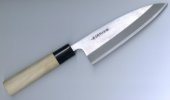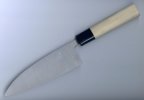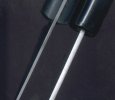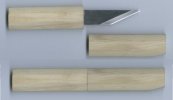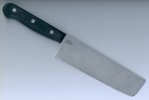- Joined
- Sep 23, 1999
- Messages
- 3,831
Lately I've been making a bunch of kitchen knives, and I also am ready to have a kogatana heat treated. For those who don't know, a kogatana is a small, single beveled knife that looks like the front edge of an americanized tanto. Really, they are the same thing as a marking knife.
Man, I sure don't know how to get to the point! Anyways, I decided that soon I'd like to combine the two styles, and make some Japanese kitchen knives! Trouble is, I've never seen any in person so I need a bit oh help.
It seems that there are 3 main blades: a Deba used for cutting meats and fish and such, a long slicer, and a Usuba hocho, wich is a vegetable knife. I know that the Deba knife is left thicker since ti cuts through fish bones and stuff. And the vegetable knife is made to be very thin for super slicing. SO here's my questions:
1) How thick is the steel for the Deba and Usuba knives? Is the Deba made from thicker stock?
2) What does the tang on these knives look like? I've seen several fighting blade tangs, but nevera kitchen knife tang!
3) How wide are the Deba and Usuba knives?
Thanks everyone!
Man, I sure don't know how to get to the point! Anyways, I decided that soon I'd like to combine the two styles, and make some Japanese kitchen knives! Trouble is, I've never seen any in person so I need a bit oh help.
It seems that there are 3 main blades: a Deba used for cutting meats and fish and such, a long slicer, and a Usuba hocho, wich is a vegetable knife. I know that the Deba knife is left thicker since ti cuts through fish bones and stuff. And the vegetable knife is made to be very thin for super slicing. SO here's my questions:
1) How thick is the steel for the Deba and Usuba knives? Is the Deba made from thicker stock?
2) What does the tang on these knives look like? I've seen several fighting blade tangs, but nevera kitchen knife tang!
3) How wide are the Deba and Usuba knives?
Thanks everyone!

